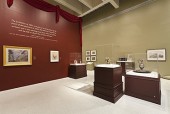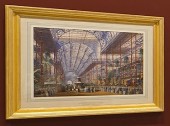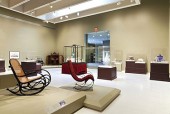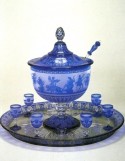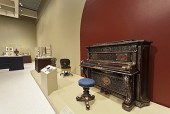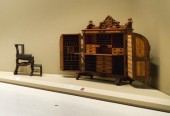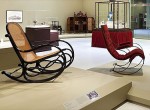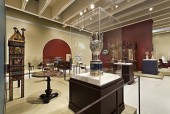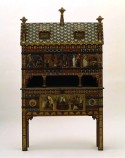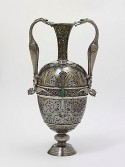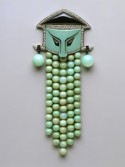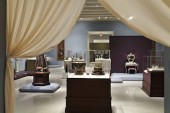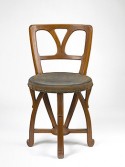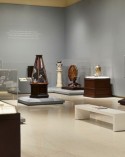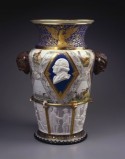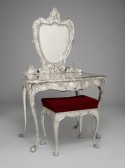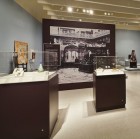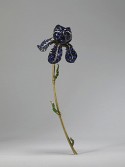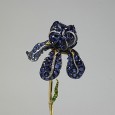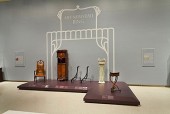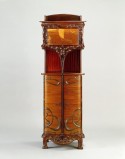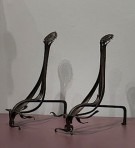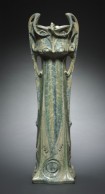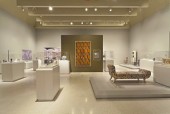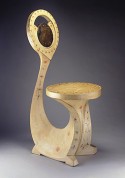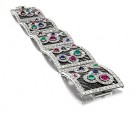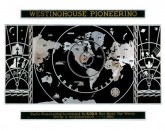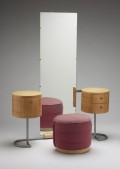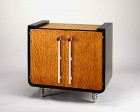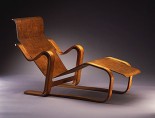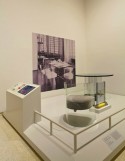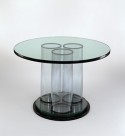The browser will either open the file, download it, or display a dialog.
Inventing the Modern World: Decorative Arts at the World’s Fairs, 1851–1939
Carnegie Museum of Art,
Pittsburgh, Pennsylvania
October 13, 2012–February 24, 2013
New Orleans Museum of Art
April 12–August 4, 2013
Mint Museum of Art, Uptown
Charlotte, North Carolina
September 21, 2013–January 19, 2014
Previously at:
The Nelson-Atkins Museum of Art
Kansas City, Missouri
April 14–August 19, 2012
Catalogue:
Inventing the Modern World: Decorative Arts at the World’s Fairs, 1851–1939.
Jason T. Busch and Catherine L. Futter, with contributions by Regina Lee Blaszczyk, Stephen Harrison, Karin A. Jones, Martin P. Levy, Dawn Reid, Ethan Robey, Annamarie V. Sandecki, Jane Shadel Spillman and Kevin W. Tucker.
New York: Skira Rizzoli International Publications, Inc. in association with the Carnegie Museum of Art, Carnegie Institute and Trustees of the Nelson Gallery Foundation, 2012.
304 pp; 260 color illus.; 43 b/w illus.; exhibiting firms, designers, and artists list; checklist of the exhibition; selected bibliography, index, list of world’s fairs, 1851–1939.
ISBN: 978-0-8478-3809-7 (hardcover)
$75.00
ISBN: 978-0-88039-055-2 (softcover)
$45.00
It is rare to describe an art exhibition as simultaneously innovative, scholarly and appealing to the general public, but Inventing the Modern World: Decorative Arts at the World’s Fairs, 1851–1939 at the Carnegie Museum of Art in Pittsburghsucceeds in all three areas. The inherent attraction of the subject of world’s fairs generates initial interest, but it is the multi-layered and nuanced presentation of the material that distinguishes this exhibition. The concept of the show is ambitious, covering not only the history of the decorative arts at world fairs from 1851 to 1939, but also the relationship between the aesthetic and technological developments of this period—and the influence of those changes on design. This project began a number of years ago when the co-curators, Jason T. Busch, Chief Curator and The Alan G. and Jane A. Lehman Curator of Decorative Arts and Design at the Carnegie Museum of Art, and Catherine L. Futter, Helen Jane and R. Hugh “Pat” Uhlmann Curator of Decorative Arts at The Nelson-Atkins Museum of Art, first considered the subject during their tenure as curators at the Minneapolis Institute of Arts. As they acknowledge in their dedication of the catalogue, it was Christopher Monkhouse, then the James Ford Bell Curator of Decorative Arts at Minneapolis (and today the Eloise W. Martin Curator and Chairman, Department of European Decorative Arts at the Art Institute of Chicago) who inspired and encouraged them to develop the concept (288).
The dramatic impact of the first world’s fair is presented at the entrance to the first gallery with a free-standing red wall draped in red bunting and lit from above, in part by skylights that the Carnegie Museum re-opened in this gallery specifically for this exhibition (fig. 1). Both the red color and the skylights pay tribute to design elements of the Crystal Palace, the immense glass and cast iron structure created by landscape architect, Joseph Paxton, for the first world’s fair in 1851 in London (fig. 2). Credit for the idea of an international exposition goes to Prince Albert, Queen Victoria’s husband, whose 1849 statement of intent is reproduced on the wall: “The Exposition of 1851 is to give us a living picture of the point of development at which the whole of mankind has arrived, and a new starting point from which all nations will be able to direct their further exertions.” Immediately below the Prince Consort’s words is Joseph Nash’s large watercolor of Queen Victoria Opening the Great Exhibition (Private collection of Frederick R. Koch,) in 1854 after it had been relocated to Syndenham just outside of London (fig. 3). The red cast-iron columns visible in the watercolor were part of architect Owen Jones’s interior design scheme utilizing primary colors to identify the circulation patterns throughout this enormous building. Like Paxton’s building, the products on display at the Great Exhibition of the Works of Industry of All Nations reflected Britain’s belief that industrialization brought both economic power and global prestige; this is underscored by numerous color lithographs, shown only at the Carnegie Museum venue, depicting scenes in which fair-goers stare in amazement at new products. The 1852 lithograph titled Hardware at the Great Exhibition (Victoria and Albert Museum, London) from Joseph Nash’s souvenir album, Comprehensive Pictures of the Great Exhibition, features an image of visitors fascinated by extravagant lighting fixtures, doorknobs, decorative plaques and fire screens. Printed guides such as this one, which was lavishly produced by Dickinson Brothers, became a standard promotional feature at future fairs.
From the outset, the world’s fairs were organized to serve several functions. First and foremost was the display of new industrial products ranging from farm equipment to the fine arts; second was the opportunity to study the products of many nations to learn new ways of approaching industrial design challenges; and, third, the fairs offered a unique venue for sales, generally in the form of placing an order for future delivery. Martin P. Levy explained the typical business persepctive in his essay on “Manufacturers at the World’s Fairs: The Model of 1851”. “For many fairgoers, the Great Exhibition prompted their first trip to London. In addition to high society, vast swaths of the middle class attended, both professionals and tradesmen. To exhibitors, all the groups represented potential business. Local committees also ensured that parties of artisans and other workers were able to benefit from the exhibition’s much-vaunted educational opportunities. The middle class, as aspirational consumers, offered manufacturers the greatest potential for new business. Having captured their attention, manufacturers made efforts to maintain it through targeted advertising” (40). This included the frequent use of advertisements that referenced a manufacturer’s participation in the fairs, and even newspaper supplements touting services like Thomas Cook’s special travel excursions to the fair; in 1851, his tour programs were responsible for bringing 150,000 visitors to the Great Exhibition (44).
This first gallery at the Carnegie Museum introduced several design elements that were consistent throughout the exhibition. By establishing these visual cues at the outset, visitors quickly understood that the galleries were designed to suggest the original environments of the fairs in abstracted forms. One of the most notable was the use of display casework and design features that reflected the aesthetic of the time period on view (fig. 4). In this room, the visitor was introduced to the earliest of the international expositions in part by the re-use of a wooden display case originally purchased by the Carnegie Museum of Art in 1907; the central case was draped in red velvet skirting similar to that used at the Great Exhibition. Appropriately, the historical design referenced on the casework exteriors were paired with contemporary environmental controls on the interiors in order to protect each object, thus combining aesthetics and technology just as the decorative arts displays at the fairs did.
Another element introduced in this gallery, and designed specifically by the Carnegie Museum staff, was the interactive media stations, in this case exceptionally well designed to provide genuinely helpful and engaging background on a variety of subjects (fig. 4). Positioned to the right of the entrance doors directly below a didactic wall panel on “Technology and Ingenuity” was an interactive media station that focused on how to make cameo glass; that process could then be immediately assessed by viewing the adjacent display case containing the porcelain footed bowl, Coupe de Rivoli, (The Nelson-Atkins Museum of Art, Kansas City) designed by Sèvres Manufactory and shown at the Exposition Universelle, Paris in 1867. In a refreshing departure from the typical computerized approach to interactive media, the twelve stations scattered throughout the exhibition demonstrated that information, illustrations and in-depth historical background could be offered in many forms, from videos and reproductions of historical pamphlets to computerized technological process demonstrations.
The theme of “technology and ingenuity” in this gallery continues with a display of new techniques in glassmaking, including a large Baccarat Lidded Punch Bowl displayed at the Exposition Universelle, Paris in 1867 (Corning Museum of Glass, Corning, New York) (fig. 5). Jane Shadel Spillman explains the new technique in her catalogue essay, “J. & L. Lobmeyr: A Case Study of Glass at the World’s Fairs”: “The continuously wrapping scene was executed using the inventive process of acid etching, in which a resist was placed on the glass and the whole was submerged in hydrofluoric acid and potassium fluoride that ate away at the surface and left the design in relief, creating definition and shading of the figures and palmettes” (95). Despite this innovative technology, the decorative scene on the punch bowl features a classical Bacchanalian subject that is entirely in keeping with mainstream Beaux-Arts design of its time. This seeming contradiction between conventional subjects and new industrial processes is at the heart of many of the revival styles during the nineteenth century, not only in glass and ceramics, but in furniture design as well. In his essay on “'Modern Renaissance’: Revival and Progression in Decorative Arts at the World’s Fairs”, co-curator Jason Busch addresses the question of revival styles in all media, noting that: “The succession of nineteenth-century revival styles-Greek, Gothic, Rococo, Renaissance-also coincided with the advancement of modern machine production in the Western world. The effect was accessible, affordable, popular consumer goods that bore witness to invention as much as to layers and eras of historical design” (51). Cloaking the inventive developments of industrialization in the familiar design vocabulary of revival styles was an accepted strategy for introducing a new technology to the public.
Furniture design, particularly the Renaissance Revival style popular from 1850–1900, was a logical outgrowth of the Gothic Revival style that had so dominated British architectural design in the first half of the nineteenth century. Like its predecessor, Renaissance Revival design was based on architectural forms, but it also referenced the historical glamour of the Medici’s Florence and the Parisian courts of Henri II and François I, all of which were centers of intellectual and cultural sophistication that appealed to Victorian civic and business leaders. The Renaissance design motifs, however, often concealed inventive processes or techniques and sometimes imaginative new ideas, such as the papier-mâché Pianoforte and Stool (ca. 1867, Carnegie Museum of Art) by John Bettridge and Company of Birmingham (fig. 6). The company had considerable experience in creating architectural ornamentation in papier-mâché, but the manufacturing of a pianoforte must have seemed an improbable goal. Bettridge’s process involved pasting sheets of durable paper together until it achieved the desired thickness, after which it was imbued with a mixture of linseed oil and tar spirits to waterproof it. Next, the surface was japanned, gilded, and decorated with mother-of-pearl. The four colored panels, called verre églomisé (decoration under glass), were created by covering glass beads with foiled aluminum. The result was a Renaissance Revival style piano made of papier-mâché, and the focus of much attention at the Paris Exposition Universelle in 1867.
In Indianapolis, Indiana William S. Wooten’s more practical Wooton Patent Office Cabinet Secretary (1880–84, High Museum of Art, Atlanta) reflected a similar sensibility (fig. 7). It too presents a carved Renaissance Revival exterior, while the interior of the piece is a marvel of file drawers, open slots and deep doors containing a multitude of storage spaces. Like many innovations from this era, it can only be described as functionally ingenious; and in this case, also a demonstration of a sophisticated structural system that maintains the desk’s stability. As Busch notes in his essay, “it represents efficiency and effective mass production. Ever the salesman, William S. Wooten and his company offered four different grades of his patented desk ...each level providing more richly decorated and expensive surfaces” (89). When the model for it was displayed at the 1876 Centennial Exposition in Philadelphia, it attracted attention from all parts of the country, and clients as famous as Ulysses S. Grant and John D. Rockefeller (89).
In contrast to the dominant revival styles, there were also objects on display that defied many assumptions about the development of an industrial design aesthetic in England. One of the most surprising pieces in this exhibition was the cast iron Rocking Chair, ca. 1850, (Cooper Union for the Advancement of Science and Art, New York) designed by R. W. Winfield of Birmingham (fig. 8). With its clean curved lines and carefully balanced equilibrium, it seems to foreshadow not only Gebrüder Thonet’s famous bentwood Rocking Chair No. 10 (High Museum of Art, Atlanta) from 1860, but also the much later tubular steel chairs designed by Marcel Breuer in the 1920s. In all of these examples, the chair designs illustrated the potential offered by new technologies and materials (or new technologies applied to old materials).
Moving into the second section of the first gallery, visitors could continue to explore revival styles in conjunction with technological virtuosity (fig. 9). Of particular interest are two objects that combine classical and gothic revival elements in decidedly different ways. First is the Yatman Cabinet, a writing desk designed by architect William Burges in 1858 (Victoria and Albert Museum, London) and exhibited at the 1862 International Exhibition in London (fig. 10). The steep pitch of the cabinet’s top echoes the architectural forms of medieval gothic furniture while Nathaniel Hubert John Westlake’s painting is characteristic of the gothic revival style popular in England at the time. What is unusual is the use of classical decorative images within the context of a gothic revival form and style of painting; these include the figure of the Phoenician prince Kadmus, who taught the alphabet to the Greeks, as well as the philosopher Anaxagoras and his friend, Pericles, the Athenian leader who presided over the classical age. In addition, there are allegorical figures of History and Poetry. Although the late gothic period is represented by the figures of the Italian poet, Dante Alighieri, and the English publisher, William Caxton, the primary means of communicating the importance of writing and printing in the Yatman Cabinet is through the use of classical references. This uncommon juxtaposition of design vocabularies is reversed in the impressively large Tennyson Vase, a 42.5 inch, silver vase honoring the English poet, Alfred Tennyson (Carnegie Museum of Art) (fig. 9; foreground). Manufactured by C. F. Hancock & Sons and designed by Henry Hugh Armstead in 1867, the shape of the vase is based directly on traditional Greek amphorae, and the silver and silver gilt figures reflect a classical approach to sculpture. However, the high relief figures embody the story told in Tennyson’s poems about the medieval legend of King Arthur and Guinevere.[1] Nothing could be farther from classical Greece in spirit and style than this Christian version of an early medieval tale as seen through a mid-nineteenth century cultural prism. And yet, neither critics nor the public seem to have perceived any discontinuity in these styles (165–67). It was exhibited initially at the 1867 Exposition Universelle in Paris, and again at the 1873 Weltausstellung in Vienna, receiving positive critical attention and warm public appreciation at both world fairs. Although it might seem somewhat incongruous at first glance, this fluid mixing and blending of design styles and formal elements is another reflection of the growing acceptance of the eclecticism in design. Revival styles and technological innovations co-existed comfortably in many decorative art media; it is not surprising then to learn that positioning classical and medieval forms and subjects together in one piece was equally welcome. This pluralism and diversity was a part of the attraction of the international exhibitions.
Before passing into the next large gallery of Inventing the Modern World, the viewer might look back to note the use of the thin metal railings surrounding many of the display platforms (fig. 9). Like the wooden casework, these barriers were designed by the Carnegie Museum to echo the railings used at the early world’s fairs, and in fact, were based on those shown in Dickinson’s Illustrated Compendium of the Great Exhibition. Similarly, the use of warm olive-colored walls with accents of intense reds and blues provided visual cues very much like those designed by Owen Jones for the Crystal Palace.
Having been thoroughly introduced to the issues of historicism, revivalism and technological innovations in decorative arts in this first large gallery, the curators next addressed the complex question of cross-cultural design. The vast majority of the host nations for the world’s fairs were imperial powers with close, and sometimes challenging, connections to their colonies. As Catherine L. Futter noted in her catalogue essay “The Federation of Mankind”: Cross-Cultural Influences in Decorative Arts at the World’s Fairs”, the international expositions “allowed diplomats, manufacturers, designers, artisans, and an enthusiastic public to have immediate and direct experience with objects, materials, technologies, and peoples from around the world” (105). Equally important in encouraging this general enthusiasm for international awareness was the increased sophistication of printing processes that made it possible for the reproduction of both photographic and colored images in the numerous design journals of the time; and the faster, more efficient transportation systems enabled the distribution of these publications to a much wider audience. In addition, the gradual acceptance of public education in many industrialized nations meant that there was a growing population that could read the new magazines and explore ideas about design from a global perspective.
The cross-cultural influences came from many sources. The Orientalist tradition of the early nineteenth century continued, especially in France, and by mid-century had expanded to include Islamic and Byzantine design elements as well. The steel and silver Vase (1855, Victoria and Albert Museum, London) by Frédéric-Jules Rudophi, a Danish goldsmith working in Paris, illustrates this well (fig. 11). The pierced steel, a clearly industrial material, is covered with damascened silver and gold arabesques typical of Islamic work, and then the whole is decorated with rubies, emeralds and turquoise. In addition to the middle eastern sources, Futter suggests that the eagles forming the handles have their origins in twelfth century French textiles or metalwork (114). By the 1920s, jewelry designers were beguiled by Howard Carter’s discovery of the tomb of the pharaoh Tutankhamon in Egypt and the Maison Cartier began producing bracelets and belt buckles with New Kingdom design elements ranging from scarabs to faience beads supplemented with diamonds and sapphires (218). One of the most striking pieces in the exhibition, however, is a Chinese-influenced Corsage Ornament (Metropolitan Museum of Art, New York) designed by jeweler Georges Fouquet in 1923 (fig. 12). Made of jade and black onyx with a diamond border and a five-strand curtain of jade beads, the Ornament is based on a Chinese mask design.
It is also in this gallery devoted to the myriad non-western design influences that the visitor is introduced to the idea of Japonisme, the craze for Japanese design that began in the 1860s and continued well into the twentieth century. Artworks from Japan are displayed here side by side with western interpretations of Japanese motifs and forms. A silver and gold Vase with “Three Friends of Winter”: Pine, Plum, and Bamboo” (1876, The Walters Art Museum, Baltimore) might be compared to the nearby Tiffany and Company Conglomerate Vase (1878, Private Collection), which is made of silver with copper, gold, iron and niello additions, all designed in the japoniste style. The western textile industry, especially luxury fabrics, also fell under the enchantment of Japanese design, adapting their characteristic natural motifs and brilliant coloration. As Futter notes, “the Japanese aesthetic also significantly shaped the development of the silk industry in Lyon.... In an opulent cut-velvet design of fluttering peacock feathers, shown at the 1889 fair in Paris, Maison Ogier et Duplan created a sense of movement which is dazzlingly highlighted by the use of gilded threads and jewel-like tones” (126). The engagement with Japanese design will continue into the following galleries, influencing art nouveau designers particularly, but also becoming an integral part of western design as a whole.
At the juncture of the next gallery, a cream-colored drapery announced the shift to the late nineteenth century and the beginning of the twentieth century, and as with previous exhibition design elements, this one is based on an example from one of the fairs (fig. 13). In this case, it was the Paris Exposition Universelle in 1900 at which visitors entered the United States beaux-arts pavilion through a draped archway. Here, the drapery signals not only the turn of the century, but also the development of art nouveau, and subsequently, 20th century modernism. The earth-toned olive walls of the previous spaces give way to a cool blue-grey paint punctuated by maroon casework and one eggplant-colored wall showcasing a spectacular silver Gorham dressing table.
The theme in this first section of the room is twofold: to the right of the entrance is “Exploration and Appropriation” and to the left is “Nationalism”. Like the themes of cross-cultural influences and colonialism in the previous gallery, these are complex-and frequently complicated-issues. Appropriation is often a form of nationalism as well as a vehicle for exploring new ideas from either colonial cultures or the distant past. Paul Hankar’s Chair exemplifies the layers of meaning that can be present in even a seemingly straightforward object (fig. 14). Trained as an architect and a sculptor, Hankar, together with Henry Van de Velde, Gustave Serrurier-Bovy, and Georges Hobé, was asked to design the Congo section of the 1897 Exposition Internationale de Bruxelles. However, the so-called Congo Free State was not actually a colony of the Belgian government, but rather the privately-owned property of King Leopold II, an extraordinary arrangement that resulted in the extreme exploitation of Congo’s natural resources and its people (138–43). Part of King Leopold’s goal in commissioning a Congo section at the fair was “to quiet unfavorable reports regarding the treatment of the native peoples and to encourage Belgian manufacturers and artists to purchase these natural resources” (143). Hankar’s chair takes full advantage of the rich Congolese mahogany available to him, but he also designed this piece in what was then known as le style congo, which was based on authentic African forms. “The basic form of the seat, with its bowed legs and brass tacks, is reminiscent of a Congolese Luba tabouret, or stool; the chair back, a completely European concept that is absent from traditional Central African seating, becomes an abstracted face, recalling African masks” (143). This adaptation of African forms resonates with Hankar’s aesthetic curiosity about non-Western cultures, linking this chair not only to his work as an art nouveau designer, but also to the emerging interest in abstraction in painting, sculpture and architecture.
Following the theme of appropriation in a slightly different direction, the exhibition also featured a grouping of Scandinavian objects that embodied a distant Viking past, albeit in contemporary art nouveau form. Ethan Robey’s essay offers particular insight into the combination of exoticism, industrialization and politics that compose the fascination not only with historical Vikings, but also with the legends of pre-Christian Norway (181). He points out that “well publicized archaeological finds in Norway fed the public imagination, including the discovery in 1880 of a nearly complete burial ship at Gökstad farm in the southwest” (181). That ship provided the model for building a nineteenth-century Viking ship that would sail from Bergen, Norway to Chicago for the 1893 World’s Columbian Exposition on the shores of Lake Michigan. Simultaneously, the silversmithing firm David-Andersen designed elegant Viking ships in the guise of centerpieces. Also on display in this Scandinavian grouping was Gerhardt Munthe’s wool and cotton tapestry entitled The Daughters of the Northern Lights (1889, Dr. David and Susan Werner collection), an expressive and elegant depiction of an encounter between three women and three, presumably magical, polar bears. Robey cites a particularly trenchant reaction from a French critic, O. Gerdell, who reviewed Munthe’s tapestry at the Paris 1900 Exposition and commented that he was “enthralled at how, in the thin air of the north where there is no fog, colors could seem so much more pure than in France” (182).[2] Munthe’s ability to transform traditional Norwegian lore into images that evoked a sense of wonder and delight in contemporary terms not only facilitated renewed interest in tapestry, but also set the stage for Norway’s leadership in this particular medium in the decades to come.
Turning to the theme of nationalism on the opposite side of the gallery space, the focus is primarily on the United States’ gradually expanding presence as a part of the industrialized west (fig. 15). Like the concise grouping of Scandinavian design across the room, this corner of the gallery gave viewers a glimpse of American decorative arts as the country matured and began to define its own national iconography. Key to this process was the 1876 Centennial International Exhibition in Philadelphia, the nation’s celebration of the one hundredth anniversary of the founding of the republic. Coming a mere decade after the end of the Civil War, the Centennial Exhibition was also a symbolic statement that the nation was united, even if that wasn’t entirely true. By focusing attention on the shared values of the American Revolution and the hope that industrialization would bring progress and prosperity, the fair organizers sought both national amity and international attention. Inevitably, George Washington figured prominently in establishing an iconographic vocabulary that all Americans could accept. Karl L. H. Müller’s Century Vase (1876, High Museum of Art, Atlanta) was a classic example of how Washington’s symbolic presence reinforced an appreciation of a common heritage (fig. 16). Manufactured by the newly founded Union Porcelain Works in Brooklyn, the 22.5 inch vase is awash in American images presented in the neoclassical style of Josiah Wedgwood. Washington takes pride of place with a two identical relief carvings on opposite sides of the vase; the handles on the other sides take the form of brown-glazed bison heads. The lower register, in white relief scenes set against a buff background, depicts the American Revolution and stories of the early settlements, while painted scenes of nineteenth-century inventions fill in the upper register between the reliefs of Washington. Around the rim, a golden American eagle shimmers amid a shower of stars and flashing gold lines. In short, the Century Vase did exactly what was intended: it offered a shorthand history of the 'democratic experiment’, showcased American ingenuity, and reminded viewers that although the American union might be fragile, it was still functioning. And the Union Porcelain Works could claim that their design and production was the equivalent of any European competitor.
Spotlighted against an eggplant-colored dividing wall in the middle of the gallery is a Dressing Table and Stool (1899, Dallas Museum of Art) designed by William C. Codman for Gorham Manufacturing Company (figs. 13 and 17). Although this extravagant sterling silver and ivory set seems to belong in a fairy tale, it is an apt reflection of the American gilded age. There are hints of the entwining foliage and vines characteristic of art nouveau, but it is primarily a reinterpretation of eighteenth-century English furniture forms. As Stephen Harrison comments in his essay on “Modernity Revealed: The World’s Fairs from 1900–1925”, this design “can be seen as a metaphor for the contrast between old and new at the fairs” (198). It is an exuberant and extravagant fantasy, and in the context of the exhibition, it sets the stage for the fantastical jewelry displayed on the opposite side of the eggplant-colored wall. There, the visitor finds a large photographic reproduction of René Jules Lalique’s booth at the Paris Exposition Universelle in 1900, marking his debut as a solo artist at a world’s fair (fig. 18). In the nearby display case was a Stick Pin (1898, Designmuseum Danmark, Copenhagen) that announced the jeweler’s transition to a definitively art nouveau style. Harrison describes it as a “masterpiece of the collection...featuring a wasp about to land, something rather unsettling to contemplate yet too titillating to pass up” (194).
In the adjacent case was a display of several pieces from Tiffany & Co. The American firm had long been a participant in international expositions, beginning in 1853 with the New York Exhibition of the Works of Industry of All Nations. Annamarie V. Sandecki’s discussion of Tiffany & Co. in her essay “All the Ages of the World: Inspiration and Innovation from Tiffany & Co. at the World’s Fairs” provides a clear overview of the evolution of this key design firm as it built an international reputation through the world expositions. Initially, the firm was recognized primarily for its silver, moving from a “Saracen” style to Japonisme to designs based on the indigenous traditions of both North and South American tribes (148). The shift to an emphasis on glass and jewelry happened gradually, but by 1900, the art nouveau designs of Louis Comfort Tiffany had taken center stage (158). Sandecki describes his Flora-style jewelry: “The subject matter, flowers that are “commonly met in the field or woods,” was crafted with unusual gemstones and with metals that were combined for artistic impact....” (158). The Corsage Ornament (1900, The Walters Art Museum, Baltimore) in the shape of a nine-inch-high iris, is just one example (figs. 19 and 20). Made of Montana sapphires, diamonds, demantoid garnets, topaz, blued steel, gold alloys and platinum, this irresistible brooch was purchased at the Exposition Universelle by Henry Walters for his collection back home in Baltimore.
Completing this gallery is a platform dedicated to the art nouveau pavilion developed for the Exposition Universelle in 1900 by Siegfried Bing, the entrepreneur who not only coined the term “art nouveau” but was responsible for tirelessly promoting this modern aesthetic (fig. 21).[3] The selection of pieces here included both items from Bing’s pavilion and from other fairs where art nouveau furnishings were featured. The architectural outline on the wall reiterated the design of the original 1900 pavilion entrance, and served to draw viewers’ attention to the stylistic shift to a modern vision of decorative arts that embraces technology in the context of a fresh design vocabulary. Louis Majorelle’s Cabinet (1900, Indianapolis Museum of Art) not only celebrates the natural grains of mahogany, kingwood and amaranth woods, but also offers a charming japoniste inlaid panel of a fishing boat setting sail at dawn (fig. 22). The importance of Japanese influence on western design cannot be understated during this time period. Japonisme was a consistent and pervasive element in decorative arts ranging from furniture design and the revival of stained glass work to the art pottery movement in the U.S. Virtually no aspect of the decorative arts--or painting and architecture--was immune. The work of the German artist, Otto Eckmann is another example of the omnipresent japoniste qualities in art nouveau decorative arts. Eckmann’s study of Japanese woodblock prints is plainly evident in his tapestry design, Five Swans (1897, The Wolfsonian-Florida International University, Miami Beach) which utilized the flattened, graphic forms characteristic of uikiyo-e printmakers (fig. 23).
An appreciation of the material properties of various media was also apparent in these art nouveau objects. Louis Majorelle’s Andirons (Iparmüvészeti Múzeum, Budapest), seen here for the first time outside of Budapest since their debut at the 1900 Exposition, are a virtuosic paean to the material properties of iron as well as a resounding declaration about embracing the “new art” (fig. 24). And the 1903 ceramic Vase des Binelles (The Cleveland Museum of Art)by Hector Guimard spotlights the crystalline glaze originally discovered by accident at the Sèvres Porcelain Manufactory in 1885 (fig. 25). Although Sèvres wasn’t initially interested in developing this glaze, by 1898 the management had come to understand its value. Like Majorelle’s Andirons, the Vase des Binelles reveals both masterful technique and expressive form in its gradated tones of blues and greens and its flowing organic shape. Guimard’s vase was shown at the Louisiana Purchase International Exposition in St. Louis, Missouri in 1904.
The third and fourth galleries of Inventing the Modern World led the visitor through the transition from the design reform movements of fin-de-siècle Europe into the more streamlined forms of the first three decades of the twentieth century (fig. 26). The Esposizione Internazionale d’Arte Decorativa Moderna held in Turin in 1902 illuminated this transition with its juxtaposition of the contrasting design vocabularies of Carlo Bugatti and Joseph-Maria Olbrich. Where Bugatti’s famous Cobra Chair (1902, Carnegie Museum of Art) is indisputably eye-catching, either singly or as part of his design for a lounge/game room, it is also a work of imagination rather than practical function (fig. 27). Parchment-covered wooden seats will simply not stand up to more than very occasional use. In contrast, Olbrich’s Side Cabinet, (1902, Nelson-Atkins Museum of Art) also shown in Turin, speaks to the need of ordinary people for furniture that is both elegant and functional without resorting to historical references in its form.
After a break in the world’s fairs for World War I, the exhibition schedule began again in 1922-23 with an exposition in Rio de Janeiro. The impact of the war, however, had reduced the size and scope of the fairs as European nations in particular struggled to repair the damage-physical, economic and psychological-that had been done. It wasn’t until the influential 1925 Exposition Internationale des Arts Décoratifs et Industriels Modernes in Paris that some of the vibrance returned. Although the scope of this fair was smaller than the pre-World War I events, it nonetheless encouraged a critical exchange of design ideas and techniques. The Viennese glassmaker J. & L. Lobmeyr had long been a participant at the world’s fairs, and in 1925, the firm made an appearance with several new designs. One was the strikingly simple form of the wine decanter from Lobmeyr’s “Ambassador” series, executed in extremely thin-walled clear glass; Jane Shadel Spillman notes, however, that the form was “considered markedly new but in essence recalled Lobmeyr’s noteworthy designs of the 1860s” (103). The design of the Centerpiece with Bowls from the “Rare Earths” series took a completely different aesthetic approach (fig. 28). The glass was infused with uranium to create vibrant orange, greenish-yellow and pinkish-purple tones and then molded into biomorphic shapes that suggest molten glass. The reflections on the irregular surfaces creates several additional layers of patterns that shift with the light and the angle of view.
Needless to say, the 1925 Exposition was also a feast of luxury and elegance embodied in the term “art deco” which arose from this gathering of designers. As with all world’s fairs, the host nation always hoped to establish their own design credibility in a global marketplace, and in 1925, France was especially eager to reiterate its leadership role as a center of style, art and culture. Paris jewelers such as Maison Boucheron were glad to assist in this effort, creating pieces such as the exquisite Bracelet (1925, Siegelson, New York) with diamonds, rubies, sapphires and emeralds set in platinum osmium and gold (fig. 29). The gems are intended to represent bubbles floating in water, mimicking the reflections of colored light that played over the Lalique crystal fountain that was the centerpiece of the Paris fair.
In spite of the 1929 collapse of the U.S. stock market, and the subsequent international economic crisis, the world’s fairs continued throughout the 1930s. With the exception of 1932, there was an international exposition somewhere in the world every year up until 1939/40 when Europe was engulfed in war.[4] Chicago’s 1933–34 Century of Progress International Exposition focused on new developments in science and technology during the worst years of the Great Depression when optimism about the future was dwindling. Nonetheless, the fair organizers, who were celebrating the city of Chicago’s centennial, emphasized the promise of technology and its potential for creating better lives for everyone. The House of Tomorrow designed by Keck and Keck Architects attracted some of the largest crowds at the fair, offering a vision of how ordinary people might live in the coming decades, complete with a tuck-under garage in which to park the family airplane. In his essay on “Style through Science: Modern Industrial Design and the World’s Fairs of the 1930s,” Kevin W. Tucker explained: “many firms effectively interwove the realms of the imagination, commerce and the home. Westinghouse, for example, asserted its prominence in the field of radio in its native Pittsburgh on a panel within the fair’s Communications Building, while it also promoted a model kitchen, aimed toward the female consumer, which offered modern appliances in a scientific plan based on efficiency studies” (231). Westinghouse’s Radio Broadcasting Panel (1933, The Wolfsonian-Florida International University, Miami Beach) in fact combines advertising for Pittsburgh’s KDKA radio station and Westinghouse’s claim to be a pioneering company (fig. 30). Owned and operated by Westinghouse in the 1920s, KDKA was the world’s first commercial radio station; it began broadcasting on November 2, 1920 when it announced the presidential election results as they were being tallied. By 1921, the station was airing music, news and sports daily, thus giving rise to the slogan at the bottom of the panel: “Radio Broadcasting As Initiated By KDKA Has Made The Whole World A Neighborhood...1920.” This panel was also a vehicle for Westinghouse to display a product called micarta, a composite of linen, canvas, paper, fiberglass, and carbon fiber impregnated with phenolic resins and then subjected to high pressure and high temperatures to create a laminate. Combined with dyed aluminum in this large panel, it became a sophisticated graphic to promote Westinghouse as an international and innovative corporation.
This aesthetic of technology was evident throughout the Century of Progress fair, and nowhere was it more clearly displayed than in the series of sixteen model homes that featured technologically advanced appliances and furniture that embodied both new industrial materials and elegant streamlined design. These houses, which were moved to Beverly Shores, Indiana in 1935, offered fairgoers the opportunity to dream of “fashionably modern living and of a future to be realized by limitless faith in technological and scientific advancement” (231).[5] Just as Paris had hoped to showcase its position as a cultural leader at the 1925 Exposition Internationale des Arts Décoratifs et Industriels Modernes, so too Chicago sought to celebrate its centennial by affirming its own groundbreaking role in American design and architecture.
Equally important for manufacturers, the Century of Progress exposition was an opportunity to create a taste for modern design even though most consumers would not be able to purchase new household furnishings for many years to come. Credit for these modernist design exemplars must be given to the extremely influential, but often unheralded, furniture manufacturing companies of Grand Rapids, Michigan, home to nearly 600 furniture companies between 1800 and the present.[6] Gilbert Rohde’s Vanity and Ottoman (1934, Yale University Art Gallery, New Haven, Connecticut) was produced by Herman Miller Furniture Company of Zeeland, Michigan (24 miles from Grand Rapids) and combines understated, sophisticated design with an appreciation of combining traditional and contemporary materials in new ways (fig. 31). Delightfully simple Bakelite knobs adorn the red elm wood drawers of the vanity; and a traditional round ottoman was placed in front of a borderless mirror anchored in a chromium-plated steel frame that also supports the vanity. Similarly, Ralph Widdicomb’s Cabinet (1933, The Wolfsonian-Florida International University, Miami Beach) proffered the concept of modern living with style (fig. 32). Manufactured by John Widdicomb Company of Grand Rapids, the Cabinet was designed for the Florida Tropical Home at the fair and incorporated plywood, avoirdiré veneer, chromium-plated steel, Bakelite and aluminum in an expressive, slightly extravagant form. One of the publications associated with the Florida Tropical Home exhibition explained the design approach in language that sounds remarkably similar to that of the Manifesto for the first Bauhaus exhibition in 1923: “With an unprecedented public encouragement of a new freedom of expression, designers may give unrestricted rein to their talent rather than to be held down to the copying of traditional periods or styles that have little in common with our lives as we live them today” (236).[7] Former Bauhaus instructor Marcel Breuer, whose Long Chair (Carnegie Museum of Art) was produced in 1936 by the London-based Isokon Furniture Company and exhibited at the Golden Gate International Exposition San Francisco in 1939, would have been entirely comfortable with this philosophy (fig. 33). Like Widdicomb’s Cabinet, the Long Chair is both expressive and startlingly new in its manipulation of form and materials, showing both the influence of Alvar Aalto’s contemporary bentwood plywood furniture and a striving for an ergonomic shape that will support human comfort.
Inventing the Modern World concludes with the New York World’s Fair in 1939. Following Chicago’s Century of Progress theme, New York chose to explore the World of Tomorrow, again emphasizing an optimistic faith in a future made possible by technological progress. The Pittsburgh Plate Glass Company (PPG) elaborated on this concept, creating an “All-Glass House in the Town of Tomorrow” at the fair (fig. 34). Located in the Glass Center building, a joint project by PPG, Corning Glass Works and Owens-Illinois Glass Company, the All-Glass House was a tour-de-force of technological prowess as well as an endorsement of modernist design. In her essay, “From Progress to Modernity: Invention and Innovation at the World’s Fairs,” Regina Lee Blaszcyk explained PPG’s unique position among the glass manufacturing companies: “In Pittsburgh, PPG had a small creative studio whose staff artists designed installations for the regional showrooms and for customers... Along similar lines, the Glass Center had a full-size model home outfitted with glass architectural blocks, mirrors, and transparent glass furniture created for PPG by designer Louis Dierra” (30). The display platform in the last gallery captured some of that architectural context with a large-scale photograph of the Glass Center installation on the wall behind the table, chair and glass radiator on display. The small table and chair are made of plate-glass, appearing simultaneously substantial and fragile in their transparency and clarity (fig. 35). The photograph of the installation at the New York Glass Center reveals a larger dining room set of five glass chairs surrounding a rectangular glass table (fig. 36). For 1930s fair-goers, the title of this display no doubt seemed completely appropriate: The Miracle of Glass: Its Glorious Part, Its Thrilling Present, Its Miraculous Future, as Presented at Glass Center, New York World’s Fair (30).
On the wall adjacent to the glass display were photographs of the Finnish Pavilion at the 1939 fair. This monumental pavilion, four stories tall, was designed by Alvar Aalto to demonstrate Finland’s position as an industrialized, design-conscious nation. In his description of this project, Aalto summed up what might serve as a credo for many of the exhibitions at all of the fairs. "An exhibition should be what in the early days it used to be, a general store: in which all possible objects are grouped together in a dense display—whether it be fish, cloth or cheese. Therefore in this pavilion I have attempted to provide the densest possible concentration of display, a space filled with wares, next to and above and beneath each other, agricultural and industrial products often just a few inches apart. It was no easy work—composing the individual elements into one symphony."[8]
Inventing the Modern World: Decorative Arts at the World’s Fairs, 1851–1939 more than delivered on its organizers’ goals. It presented a stunning array of objects designed to appeal to every taste imaginable, and it placed those objects in a historical context that was presented clearly and concisely. Casual visitors could enjoy the splendor of individual pieces and more serious viewers could absorb the multifaceted themes and concepts at the heart of the Carnegie Museum’s exhibition. Interactive media stations provided technical, historical and aesthetic information in appropriate formats and without becoming the annoying disruptive elements they so frequently do in contemporary exhibitions. For the art historian, this exhibition offered a sophisticated and nuanced interpretation of decorative arts at the world’s fairs, focusing not only on key objects, but also on the significance of the development of ideas, aesthetics and technological innovations as shifting facets of design over a period of ninety years.
The exhibition will travel to New Orleans and then to Charlotte, North Carolina until January 2014. However, if seeing it in person isn’t possible, then the excellent catalogue serves as a compendium of the research and thought that went into this project. There is nothing equivalent in either scope or evaluation of this subject; it will stand as the seminal analysis of the history of decorative arts at the world’s fairs for the foreseeable future. Perhaps because this exhibition was a long time in the making, it manifested the scholarly coherence that comes only from careful thought and study of the objects. Both the Carnegie Museum of Art and The Nelson-Atkins Museum of Art, as well as co-curators Jason T. Busch and Catherine L. Futter, deserve credit for supporting this effort and not succumbing to the all too common impulse to accept half-finished projects. By allowing this complex and nuanced concept to mature, they have made a genuine contribution to our understanding of cultural and aesthetic development in the decorative arts.
Janet Whitmore
jwhitmore12[at]gmail.com
The author would like to thank Jason Busch, Jonathan Gaugler and Dawn Reid of the Carnegie Museum of Art for their gracious assistance in answering questions and providing photographs of the exhibition.
[1] The specific poems referenced on the Tennyson Vase are Morte d’Arthur (1842) and Guinevere (1857). For a detailed scholarly biography of Alfred Tennyson and copies of these poems, please see the Poetry Foundation website: http://www.poetryfoundation.org/bio/alfred-tennyson.
[2] The original source for this commentary is O. Gerdell, “La Norvège à l’exposition universelle,” L’Art Décoratif 25 (October 1900): 26.
[3] For a discussion of Bing’s Pavilion de l’art nouveau, see Karin Lacquemant, “The Bing Art Nouveau Pavilion at the World’s Fair of 1900” in The Origins of L’art Nouveau: The Bing Empire, eds. Garbriel P. Weisberg, Edwin Becker, and Evelyne Possémé (Antwerp: Mercatorfond, 2004), 188–221.
[4] It should be noted that the 1939–40 fairs were hosted by New York and San Francisco before the U.S. entered World War II.
[5] Beverly Shores was a 3000-acre, speculative real estate development along the southern shore of Lake Michigan in northern Indiana. The sixteen model homes from the Century of Progress fair were moved to the community in 1935 by Robert Bartlett, a Chicago businessman who purchased the property in 1933. Today, five of the structures remain, now located within the boundaries of Indiana Dunes National Lakeshore. The Indiana Historic Landmarks Foundation currently leases the houses to individuals who have agreed to renovate them.
[6] See the Grand Rapids Historical Commission’s excellent website database on furniture companies at: http://www.historygrandrapids.org/browse/company/furniture. This database contains an exhaustive record of the 591 furniture makers in Grand Rapids.
[7] See James S. Kuhne and Percival Goodman, The Florida Tropical Home at A Century of Progress 1933 (United States, 1933?), unpaginated. For the Bauhaus Manifesto, see Programs and Manifestos on 20th-Century Architecture, ed. Ulrich Conrads (Cambridge, Massachusetts: The MIT Press, 1971), 69–70.
[8] Karl Fleig, Alvar Aalto, vol. 1 (Scarsdale: Wittenborn, 1963), 130.


